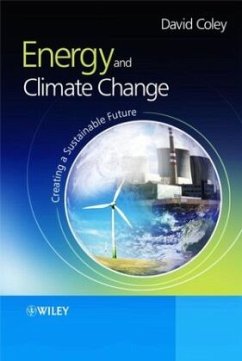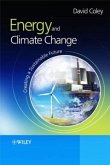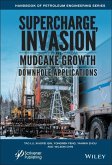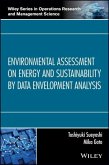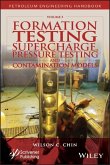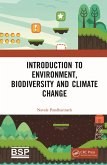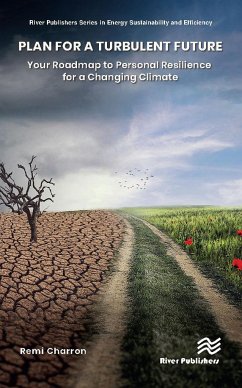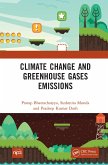- Gebundenes Buch
- Merkliste
- Auf die Merkliste
- Bewerten Bewerten
- Teilen
- Produkt teilen
- Produkterinnerung
- Produkterinnerung
Over the past twenty years or so, interest in energy, both in the abstract and in humankind's use of it, has been brought to the fore, especially since concerns over climate change have become more widely reported.
Energy and climate change discusses what energy is, why it is important, our current energy systems and more sustainable alternatives, and why energy use is having a detrimental effect on the environment. Energy is placed at the front of a discussion of the global environment, technology and civilisation.
Problem solving is a central tool and is approached through the use of…mehr
Andere Kunden interessierten sich auch für
![Energy and Climate Change Energy and Climate Change]() David ColeyEnergy and Climate Change73,99 €
David ColeyEnergy and Climate Change73,99 €![Supercharge, Invasion, and Mudcake Growth in Downhole Applications Supercharge, Invasion, and Mudcake Growth in Downhole Applications]() Supercharge, Invasion, and Mudcake Growth in Downhole ApplicationsSupercharge, Invasion, and Mudcake Growth in Downhole Applications232,99 €
Supercharge, Invasion, and Mudcake Growth in Downhole ApplicationsSupercharge, Invasion, and Mudcake Growth in Downhole Applications232,99 €![Environmental Assessment on Energy and Sustainability by Data Envelopment Analysis Environmental Assessment on Energy and Sustainability by Data Envelopment Analysis]() Toshiyuki SueyoshiEnvironmental Assessment on Energy and Sustainability by Data Envelopment Analysis126,99 €
Toshiyuki SueyoshiEnvironmental Assessment on Energy and Sustainability by Data Envelopment Analysis126,99 €![Formation Testing Formation Testing]() Wilson ChinFormation Testing232,99 €
Wilson ChinFormation Testing232,99 €![Introduction to Environment, Biodiversity and Climate Change Introduction to Environment, Biodiversity and Climate Change]() Navale PandharinathIntroduction to Environment, Biodiversity and Climate Change115,99 €
Navale PandharinathIntroduction to Environment, Biodiversity and Climate Change115,99 €![Plan for a Turbulent Future Plan for a Turbulent Future]() Remi CharronPlan for a Turbulent Future114,99 €
Remi CharronPlan for a Turbulent Future114,99 €![Climate Change and Greenhouse Gases Emissions Climate Change and Greenhouse Gases Emissions]() Pratap BhattacharyyaClimate Change and Greenhouse Gases Emissions146,99 €
Pratap BhattacharyyaClimate Change and Greenhouse Gases Emissions146,99 €-
-
-
Over the past twenty years or so, interest in energy, both in the abstract and in humankind's use of it, has been brought to the fore, especially since concerns over climate change have become more widely reported.
Energy and climate change discusses what energy is, why it is important, our current energy systems and more sustainable alternatives, and why energy use is having a detrimental effect on the environment. Energy is placed at the front of a discussion of the global environment, technology and civilisation.
Problem solving is a central tool and is approached through the use of Fermi-like problems, where the reader is encouraged to explore relevant issues through simple numeric problem solving.
_ Covers climate change, current energy technologies (e.g oil, gas, etc), renewable/alternative technologies, energy economics and the history of energy use
_ Contains numerous student exercises and case-studies from around the world
_ An invaluable text for those students taking courses in the physical sciences, engineering, earth and environmental sciences, geography and related subjects.
_ Reflects on the international community and its attempts to solve the problem of climate change
_ Additional teaching resources and weblinks available on the book's website www.wileyeurope.com/college/coley
Hinweis: Dieser Artikel kann nur an eine deutsche Lieferadresse ausgeliefert werden.
Energy and climate change discusses what energy is, why it is important, our current energy systems and more sustainable alternatives, and why energy use is having a detrimental effect on the environment. Energy is placed at the front of a discussion of the global environment, technology and civilisation.
Problem solving is a central tool and is approached through the use of Fermi-like problems, where the reader is encouraged to explore relevant issues through simple numeric problem solving.
_ Covers climate change, current energy technologies (e.g oil, gas, etc), renewable/alternative technologies, energy economics and the history of energy use
_ Contains numerous student exercises and case-studies from around the world
_ An invaluable text for those students taking courses in the physical sciences, engineering, earth and environmental sciences, geography and related subjects.
_ Reflects on the international community and its attempts to solve the problem of climate change
_ Additional teaching resources and weblinks available on the book's website www.wileyeurope.com/college/coley
Hinweis: Dieser Artikel kann nur an eine deutsche Lieferadresse ausgeliefert werden.
Produktdetails
- Produktdetails
- Verlag: Wiley & Sons
- Artikelnr. des Verlages: 14585312000
- 1. Auflage
- Seitenzahl: 672
- Erscheinungstermin: 1. Juni 2008
- Englisch
- Abmessung: 252mm x 174mm x 42mm
- Gewicht: 1295g
- ISBN-13: 9780470853122
- ISBN-10: 0470853123
- Artikelnr.: 13483966
- Herstellerkennzeichnung
- Libri GmbH
- Europaallee 1
- 36244 Bad Hersfeld
- gpsr@libri.de
- Verlag: Wiley & Sons
- Artikelnr. des Verlages: 14585312000
- 1. Auflage
- Seitenzahl: 672
- Erscheinungstermin: 1. Juni 2008
- Englisch
- Abmessung: 252mm x 174mm x 42mm
- Gewicht: 1295g
- ISBN-13: 9780470853122
- ISBN-10: 0470853123
- Artikelnr.: 13483966
- Herstellerkennzeichnung
- Libri GmbH
- Europaallee 1
- 36244 Bad Hersfeld
- gpsr@libri.de
David Coley is the author of Energy and Climate Change: Creating a Sustainable Future, published by Wiley.
Preface xiii
1 Introduction 1
Part I Energy: Concepts, History and Problems 7
2 Energy 9
2.1 What is energy? 9
2.2 Units 11
2.3 Power 13
2.4 Energy in various disguises 14
2.5 Energy quality and exergy 21
2.6 Student exercises 25
3 The planet's energy balance 27
3.1 The sun 27
3.2 The earth 31
3.3 Comparisons 41
3.4 Student exercises 43
4 A history of humankind's use of energy 45
4.1 Energy and society 46
4.2 Wealth, urbanization and conflict 66
4.3 Our current level of energy use 69
4.4 Student exercises 74
5 Sustainability, climate change and the global environment 77
5.1 Sustainability 77
5.2 Climate change 79
5.3 Other concerns 114
5.4 Debating climate change and answering the sceptics 127
5.5 The atmosphere 134
5.6 Student exercises 139
6 Economics and the environment 143
6.1 Key concepts 143
6.2 Environmental economics 154
6.3 Student exercises 158
7 Combustion, inescapable inefficiencies and the generation of electricity
159
7.1 Combustion 159
7.2 Calorific values 161
7.3 Inescapable inefficiencies 161
7.4 Heat pumps 165
7.5 Double Carnot efficiencies 168
7.6 The generation of electricity from heat 168
7.7 Student exercises 177
Part II Unsustainable Energy Technologies 179
8 Coal 183
8.1 History 184
8.2 Extraction 185
8.3 The combustion of coal 186
8.4 Technologies for use 187
8.5 Example applications 190
8.6 Global resource 193
8.7 Student exercises 196
9 Oil 199
9.1 Extraction 200
9.2 The combustion of oil 204
9.3 Technologies for use 205
9.4 Example application: the motor car 205
9.5 Global resource 208
9.6 Student exercises 210
10 Gas 211
10.1 Extraction 211
10.2 The combustion of gas 214
10.3 Technologies for use 214
10.4 Example application: the domestic boiler 215
10.5 Global resource 216
10.6 Student exercises 220
11 Non-conventional hydrocarbons 221
11.1 Oil shale 221
11.2 Tar sands 222
11.3 Methane hydrate 223
11.4 Student exercises 226
12 Nuclear power 227
12.1 Physical basis 227
12.2 Technologies for use 229
12.3 Environmental concerns 239
12.4 Waste 244
12.5 World resource 245
12.6 Example applications 248
12.7 Is nuclear power the solution to global warming? 254
12.8 Student exercises 257
13 Hydropower 259
13.1 History 259
13.2 Technologies for use 261
13.3 Example application: Itaipu hydroelectric station 268
13.4 Environmental impacts 271
13.5 Pumped storage 273
13.6 Global resource 273
13.7 Student exercises 275
14 Transport and air quality 277
14.1 Present day problems 278
14.2 Air quality and health 282
14.3 Example application: air quality in Exeter, UK 290
14.4 Student exercises 290
15 Figures and philosophy: an analysis of a nation's energy supply 291
15.1 The economy 293
15.2 Production 294
15.3 Consumption 294
15.4 Oil and gas production 296
15.5 Prices 298
15.6 Fuel poverty 302
15.7 Carbon emissions 303
15.8 Sustainable energy in the UK: the current state of play 303
15.9 Student exercises 307
Part III Climate Change: Predictions and Policies 309
16 Future world energy use and carbon emissions 311
16.1 The world's future use of energy 312
16.2 Student exercises 322
17 The impact of a warmer world 323
17.1 Climate models 324
17.2 Natural variability and model reliability 326
17.3 Future climate change 331
17.4 Impacts 331
17.5 Costing the impact 343
17.6 Student exercises 343
18 Politics in the greenhouse: contracting and converging 345
18.1 Climate negotiations 348
18.2 Another approach 355
18.3 Bringing it all together 358
18.4 Conclusion 364
18.5 Student exercises 364
Part IV Sustainable Energy Technologies 365
IV.1 Current world sustainable energy provision 367
19 Energy efficiency 371
19.1 Cogeneration 372
19.2 Reducing energy losses 374
19.3 Energy recovery 383
19.4 Energy efficiency in buildings 386
19.5 Student exercises 394
20 Solar power 397
20.1 Passive solar heating 398
20.2 Heat pumps 405
20.3 Solar water heating 409
20.4 Low temperature solar water heating 409
20.5 Example application: solar water heating, Phoenix Federal Correction
Institution, USA 416
20.6 High temperature solar power 417
20.7 Low temperature water-based thermal energy conversion 422
20.8 OECD resource 423
20.9 Student exercises 424
21 Photovoltaics 427
21.1 History 427
21.2 Basic principles 427
21.3 Technologies for use 431
21.4 Electrical characteristics 433
21.5 Roof-top PV 436
21.6 Example application: Doxford Solar Office, UK 439
21.7 OECD resource 440
21.8 Student exercises 440
22 Wind power 441
22.1 History 444
22.2 Technologies for use 447
22.3 The modern horizontal axis wind turbine 459
22.4 Environmental impacts 462
22.5 OECD resource 467
22.6 Example application: Harøy Island Wind Farm, Sandøy, Norway 468
22.7 Student exercises 469
23 Wave power 471
23.1 Wave characteristics 472
23.2 Technologies for use 474
23.3 Example application: the Pelamis P-750 wave energy converter 478
23.4 Student exercises 478
24 Tidal and small-scale hydropower 481
24.1 Tides 482
24.2 Small-scale hydropower 490
24.3 OECD resource 496
24.4 Student exercises 498
25 Biomass 499
25.1 History 499
25.2 Basic principles 500
25.3 Technologies for use 502
25.4 Example application: anaerobic digester, Walford College Farm, UK 510
25.5 Global resource 511
25.6 OECD resource 513
25.7 Student exercises 514
26 Geothermal 515
26.1 Background 515
26.2 History 519
26.3 Resource and technology 520
26.4 Technologies for use 523
26.5 Environmental problems 525
26.6 World resource 525
26.7 OECD resource 526
26.8 Example application: Hacchobaru geothermal power station,
Kokonoe-machi, Japan 526
26.9 Student exercises 528
27 Fast breeders and fusion 529
27.1 Fast breeder reactors 529
27.2 Fusion 532
27.3 Example application: JET Torus, Culham, UK 535
27.4 Student exercises 537
28 Alternative transport futures and the hydrogen economy 539
28.1 Improving energy efficiency 541
28.2 Alternative transport fuels and engines 544
28.3 Hydrogen powered vehicles and the hydrogen economy 550
28.4 Fuel cells 552
28.5 Example application: the greening of natural gas 558
28.6 Student exercises 559
29 Carbon sequestration and climate engineering 561
29.1 Capture technologies 562
29.2 Storage technologies 563
29.3 The reflection of solar radiation 567
29.4 Example application: Statoil, Sleipner West gas field, North Sea 568
29.5 Student exercises 569
30 A sustainable, low carbon future? 571
30.1 Methodology and assumptions 572
30.2 Results 572
30.3 Worldwide reductions 578
30.4 Conclusion 581
30.5 What can I do? 581
30.6 Student exercises 582
References 583
Appendix 1 National energy data 593
Appendix 2 Answers to in-text problems 613
Appendix 3 Bibliography and suggested reading 641
Appendix 4 Useful data 643
Index 649
1 Introduction 1
Part I Energy: Concepts, History and Problems 7
2 Energy 9
2.1 What is energy? 9
2.2 Units 11
2.3 Power 13
2.4 Energy in various disguises 14
2.5 Energy quality and exergy 21
2.6 Student exercises 25
3 The planet's energy balance 27
3.1 The sun 27
3.2 The earth 31
3.3 Comparisons 41
3.4 Student exercises 43
4 A history of humankind's use of energy 45
4.1 Energy and society 46
4.2 Wealth, urbanization and conflict 66
4.3 Our current level of energy use 69
4.4 Student exercises 74
5 Sustainability, climate change and the global environment 77
5.1 Sustainability 77
5.2 Climate change 79
5.3 Other concerns 114
5.4 Debating climate change and answering the sceptics 127
5.5 The atmosphere 134
5.6 Student exercises 139
6 Economics and the environment 143
6.1 Key concepts 143
6.2 Environmental economics 154
6.3 Student exercises 158
7 Combustion, inescapable inefficiencies and the generation of electricity
159
7.1 Combustion 159
7.2 Calorific values 161
7.3 Inescapable inefficiencies 161
7.4 Heat pumps 165
7.5 Double Carnot efficiencies 168
7.6 The generation of electricity from heat 168
7.7 Student exercises 177
Part II Unsustainable Energy Technologies 179
8 Coal 183
8.1 History 184
8.2 Extraction 185
8.3 The combustion of coal 186
8.4 Technologies for use 187
8.5 Example applications 190
8.6 Global resource 193
8.7 Student exercises 196
9 Oil 199
9.1 Extraction 200
9.2 The combustion of oil 204
9.3 Technologies for use 205
9.4 Example application: the motor car 205
9.5 Global resource 208
9.6 Student exercises 210
10 Gas 211
10.1 Extraction 211
10.2 The combustion of gas 214
10.3 Technologies for use 214
10.4 Example application: the domestic boiler 215
10.5 Global resource 216
10.6 Student exercises 220
11 Non-conventional hydrocarbons 221
11.1 Oil shale 221
11.2 Tar sands 222
11.3 Methane hydrate 223
11.4 Student exercises 226
12 Nuclear power 227
12.1 Physical basis 227
12.2 Technologies for use 229
12.3 Environmental concerns 239
12.4 Waste 244
12.5 World resource 245
12.6 Example applications 248
12.7 Is nuclear power the solution to global warming? 254
12.8 Student exercises 257
13 Hydropower 259
13.1 History 259
13.2 Technologies for use 261
13.3 Example application: Itaipu hydroelectric station 268
13.4 Environmental impacts 271
13.5 Pumped storage 273
13.6 Global resource 273
13.7 Student exercises 275
14 Transport and air quality 277
14.1 Present day problems 278
14.2 Air quality and health 282
14.3 Example application: air quality in Exeter, UK 290
14.4 Student exercises 290
15 Figures and philosophy: an analysis of a nation's energy supply 291
15.1 The economy 293
15.2 Production 294
15.3 Consumption 294
15.4 Oil and gas production 296
15.5 Prices 298
15.6 Fuel poverty 302
15.7 Carbon emissions 303
15.8 Sustainable energy in the UK: the current state of play 303
15.9 Student exercises 307
Part III Climate Change: Predictions and Policies 309
16 Future world energy use and carbon emissions 311
16.1 The world's future use of energy 312
16.2 Student exercises 322
17 The impact of a warmer world 323
17.1 Climate models 324
17.2 Natural variability and model reliability 326
17.3 Future climate change 331
17.4 Impacts 331
17.5 Costing the impact 343
17.6 Student exercises 343
18 Politics in the greenhouse: contracting and converging 345
18.1 Climate negotiations 348
18.2 Another approach 355
18.3 Bringing it all together 358
18.4 Conclusion 364
18.5 Student exercises 364
Part IV Sustainable Energy Technologies 365
IV.1 Current world sustainable energy provision 367
19 Energy efficiency 371
19.1 Cogeneration 372
19.2 Reducing energy losses 374
19.3 Energy recovery 383
19.4 Energy efficiency in buildings 386
19.5 Student exercises 394
20 Solar power 397
20.1 Passive solar heating 398
20.2 Heat pumps 405
20.3 Solar water heating 409
20.4 Low temperature solar water heating 409
20.5 Example application: solar water heating, Phoenix Federal Correction
Institution, USA 416
20.6 High temperature solar power 417
20.7 Low temperature water-based thermal energy conversion 422
20.8 OECD resource 423
20.9 Student exercises 424
21 Photovoltaics 427
21.1 History 427
21.2 Basic principles 427
21.3 Technologies for use 431
21.4 Electrical characteristics 433
21.5 Roof-top PV 436
21.6 Example application: Doxford Solar Office, UK 439
21.7 OECD resource 440
21.8 Student exercises 440
22 Wind power 441
22.1 History 444
22.2 Technologies for use 447
22.3 The modern horizontal axis wind turbine 459
22.4 Environmental impacts 462
22.5 OECD resource 467
22.6 Example application: Harøy Island Wind Farm, Sandøy, Norway 468
22.7 Student exercises 469
23 Wave power 471
23.1 Wave characteristics 472
23.2 Technologies for use 474
23.3 Example application: the Pelamis P-750 wave energy converter 478
23.4 Student exercises 478
24 Tidal and small-scale hydropower 481
24.1 Tides 482
24.2 Small-scale hydropower 490
24.3 OECD resource 496
24.4 Student exercises 498
25 Biomass 499
25.1 History 499
25.2 Basic principles 500
25.3 Technologies for use 502
25.4 Example application: anaerobic digester, Walford College Farm, UK 510
25.5 Global resource 511
25.6 OECD resource 513
25.7 Student exercises 514
26 Geothermal 515
26.1 Background 515
26.2 History 519
26.3 Resource and technology 520
26.4 Technologies for use 523
26.5 Environmental problems 525
26.6 World resource 525
26.7 OECD resource 526
26.8 Example application: Hacchobaru geothermal power station,
Kokonoe-machi, Japan 526
26.9 Student exercises 528
27 Fast breeders and fusion 529
27.1 Fast breeder reactors 529
27.2 Fusion 532
27.3 Example application: JET Torus, Culham, UK 535
27.4 Student exercises 537
28 Alternative transport futures and the hydrogen economy 539
28.1 Improving energy efficiency 541
28.2 Alternative transport fuels and engines 544
28.3 Hydrogen powered vehicles and the hydrogen economy 550
28.4 Fuel cells 552
28.5 Example application: the greening of natural gas 558
28.6 Student exercises 559
29 Carbon sequestration and climate engineering 561
29.1 Capture technologies 562
29.2 Storage technologies 563
29.3 The reflection of solar radiation 567
29.4 Example application: Statoil, Sleipner West gas field, North Sea 568
29.5 Student exercises 569
30 A sustainable, low carbon future? 571
30.1 Methodology and assumptions 572
30.2 Results 572
30.3 Worldwide reductions 578
30.4 Conclusion 581
30.5 What can I do? 581
30.6 Student exercises 582
References 583
Appendix 1 National energy data 593
Appendix 2 Answers to in-text problems 613
Appendix 3 Bibliography and suggested reading 641
Appendix 4 Useful data 643
Index 649
Preface xiii
1 Introduction 1
Part I Energy: Concepts, History and Problems 7
2 Energy 9
2.1 What is energy? 9
2.2 Units 11
2.3 Power 13
2.4 Energy in various disguises 14
2.5 Energy quality and exergy 21
2.6 Student exercises 25
3 The planet's energy balance 27
3.1 The sun 27
3.2 The earth 31
3.3 Comparisons 41
3.4 Student exercises 43
4 A history of humankind's use of energy 45
4.1 Energy and society 46
4.2 Wealth, urbanization and conflict 66
4.3 Our current level of energy use 69
4.4 Student exercises 74
5 Sustainability, climate change and the global environment 77
5.1 Sustainability 77
5.2 Climate change 79
5.3 Other concerns 114
5.4 Debating climate change and answering the sceptics 127
5.5 The atmosphere 134
5.6 Student exercises 139
6 Economics and the environment 143
6.1 Key concepts 143
6.2 Environmental economics 154
6.3 Student exercises 158
7 Combustion, inescapable inefficiencies and the generation of electricity
159
7.1 Combustion 159
7.2 Calorific values 161
7.3 Inescapable inefficiencies 161
7.4 Heat pumps 165
7.5 Double Carnot efficiencies 168
7.6 The generation of electricity from heat 168
7.7 Student exercises 177
Part II Unsustainable Energy Technologies 179
8 Coal 183
8.1 History 184
8.2 Extraction 185
8.3 The combustion of coal 186
8.4 Technologies for use 187
8.5 Example applications 190
8.6 Global resource 193
8.7 Student exercises 196
9 Oil 199
9.1 Extraction 200
9.2 The combustion of oil 204
9.3 Technologies for use 205
9.4 Example application: the motor car 205
9.5 Global resource 208
9.6 Student exercises 210
10 Gas 211
10.1 Extraction 211
10.2 The combustion of gas 214
10.3 Technologies for use 214
10.4 Example application: the domestic boiler 215
10.5 Global resource 216
10.6 Student exercises 220
11 Non-conventional hydrocarbons 221
11.1 Oil shale 221
11.2 Tar sands 222
11.3 Methane hydrate 223
11.4 Student exercises 226
12 Nuclear power 227
12.1 Physical basis 227
12.2 Technologies for use 229
12.3 Environmental concerns 239
12.4 Waste 244
12.5 World resource 245
12.6 Example applications 248
12.7 Is nuclear power the solution to global warming? 254
12.8 Student exercises 257
13 Hydropower 259
13.1 History 259
13.2 Technologies for use 261
13.3 Example application: Itaipu hydroelectric station 268
13.4 Environmental impacts 271
13.5 Pumped storage 273
13.6 Global resource 273
13.7 Student exercises 275
14 Transport and air quality 277
14.1 Present day problems 278
14.2 Air quality and health 282
14.3 Example application: air quality in Exeter, UK 290
14.4 Student exercises 290
15 Figures and philosophy: an analysis of a nation's energy supply 291
15.1 The economy 293
15.2 Production 294
15.3 Consumption 294
15.4 Oil and gas production 296
15.5 Prices 298
15.6 Fuel poverty 302
15.7 Carbon emissions 303
15.8 Sustainable energy in the UK: the current state of play 303
15.9 Student exercises 307
Part III Climate Change: Predictions and Policies 309
16 Future world energy use and carbon emissions 311
16.1 The world's future use of energy 312
16.2 Student exercises 322
17 The impact of a warmer world 323
17.1 Climate models 324
17.2 Natural variability and model reliability 326
17.3 Future climate change 331
17.4 Impacts 331
17.5 Costing the impact 343
17.6 Student exercises 343
18 Politics in the greenhouse: contracting and converging 345
18.1 Climate negotiations 348
18.2 Another approach 355
18.3 Bringing it all together 358
18.4 Conclusion 364
18.5 Student exercises 364
Part IV Sustainable Energy Technologies 365
IV.1 Current world sustainable energy provision 367
19 Energy efficiency 371
19.1 Cogeneration 372
19.2 Reducing energy losses 374
19.3 Energy recovery 383
19.4 Energy efficiency in buildings 386
19.5 Student exercises 394
20 Solar power 397
20.1 Passive solar heating 398
20.2 Heat pumps 405
20.3 Solar water heating 409
20.4 Low temperature solar water heating 409
20.5 Example application: solar water heating, Phoenix Federal Correction
Institution, USA 416
20.6 High temperature solar power 417
20.7 Low temperature water-based thermal energy conversion 422
20.8 OECD resource 423
20.9 Student exercises 424
21 Photovoltaics 427
21.1 History 427
21.2 Basic principles 427
21.3 Technologies for use 431
21.4 Electrical characteristics 433
21.5 Roof-top PV 436
21.6 Example application: Doxford Solar Office, UK 439
21.7 OECD resource 440
21.8 Student exercises 440
22 Wind power 441
22.1 History 444
22.2 Technologies for use 447
22.3 The modern horizontal axis wind turbine 459
22.4 Environmental impacts 462
22.5 OECD resource 467
22.6 Example application: Harøy Island Wind Farm, Sandøy, Norway 468
22.7 Student exercises 469
23 Wave power 471
23.1 Wave characteristics 472
23.2 Technologies for use 474
23.3 Example application: the Pelamis P-750 wave energy converter 478
23.4 Student exercises 478
24 Tidal and small-scale hydropower 481
24.1 Tides 482
24.2 Small-scale hydropower 490
24.3 OECD resource 496
24.4 Student exercises 498
25 Biomass 499
25.1 History 499
25.2 Basic principles 500
25.3 Technologies for use 502
25.4 Example application: anaerobic digester, Walford College Farm, UK 510
25.5 Global resource 511
25.6 OECD resource 513
25.7 Student exercises 514
26 Geothermal 515
26.1 Background 515
26.2 History 519
26.3 Resource and technology 520
26.4 Technologies for use 523
26.5 Environmental problems 525
26.6 World resource 525
26.7 OECD resource 526
26.8 Example application: Hacchobaru geothermal power station,
Kokonoe-machi, Japan 526
26.9 Student exercises 528
27 Fast breeders and fusion 529
27.1 Fast breeder reactors 529
27.2 Fusion 532
27.3 Example application: JET Torus, Culham, UK 535
27.4 Student exercises 537
28 Alternative transport futures and the hydrogen economy 539
28.1 Improving energy efficiency 541
28.2 Alternative transport fuels and engines 544
28.3 Hydrogen powered vehicles and the hydrogen economy 550
28.4 Fuel cells 552
28.5 Example application: the greening of natural gas 558
28.6 Student exercises 559
29 Carbon sequestration and climate engineering 561
29.1 Capture technologies 562
29.2 Storage technologies 563
29.3 The reflection of solar radiation 567
29.4 Example application: Statoil, Sleipner West gas field, North Sea 568
29.5 Student exercises 569
30 A sustainable, low carbon future? 571
30.1 Methodology and assumptions 572
30.2 Results 572
30.3 Worldwide reductions 578
30.4 Conclusion 581
30.5 What can I do? 581
30.6 Student exercises 582
References 583
Appendix 1 National energy data 593
Appendix 2 Answers to in-text problems 613
Appendix 3 Bibliography and suggested reading 641
Appendix 4 Useful data 643
Index 649
1 Introduction 1
Part I Energy: Concepts, History and Problems 7
2 Energy 9
2.1 What is energy? 9
2.2 Units 11
2.3 Power 13
2.4 Energy in various disguises 14
2.5 Energy quality and exergy 21
2.6 Student exercises 25
3 The planet's energy balance 27
3.1 The sun 27
3.2 The earth 31
3.3 Comparisons 41
3.4 Student exercises 43
4 A history of humankind's use of energy 45
4.1 Energy and society 46
4.2 Wealth, urbanization and conflict 66
4.3 Our current level of energy use 69
4.4 Student exercises 74
5 Sustainability, climate change and the global environment 77
5.1 Sustainability 77
5.2 Climate change 79
5.3 Other concerns 114
5.4 Debating climate change and answering the sceptics 127
5.5 The atmosphere 134
5.6 Student exercises 139
6 Economics and the environment 143
6.1 Key concepts 143
6.2 Environmental economics 154
6.3 Student exercises 158
7 Combustion, inescapable inefficiencies and the generation of electricity
159
7.1 Combustion 159
7.2 Calorific values 161
7.3 Inescapable inefficiencies 161
7.4 Heat pumps 165
7.5 Double Carnot efficiencies 168
7.6 The generation of electricity from heat 168
7.7 Student exercises 177
Part II Unsustainable Energy Technologies 179
8 Coal 183
8.1 History 184
8.2 Extraction 185
8.3 The combustion of coal 186
8.4 Technologies for use 187
8.5 Example applications 190
8.6 Global resource 193
8.7 Student exercises 196
9 Oil 199
9.1 Extraction 200
9.2 The combustion of oil 204
9.3 Technologies for use 205
9.4 Example application: the motor car 205
9.5 Global resource 208
9.6 Student exercises 210
10 Gas 211
10.1 Extraction 211
10.2 The combustion of gas 214
10.3 Technologies for use 214
10.4 Example application: the domestic boiler 215
10.5 Global resource 216
10.6 Student exercises 220
11 Non-conventional hydrocarbons 221
11.1 Oil shale 221
11.2 Tar sands 222
11.3 Methane hydrate 223
11.4 Student exercises 226
12 Nuclear power 227
12.1 Physical basis 227
12.2 Technologies for use 229
12.3 Environmental concerns 239
12.4 Waste 244
12.5 World resource 245
12.6 Example applications 248
12.7 Is nuclear power the solution to global warming? 254
12.8 Student exercises 257
13 Hydropower 259
13.1 History 259
13.2 Technologies for use 261
13.3 Example application: Itaipu hydroelectric station 268
13.4 Environmental impacts 271
13.5 Pumped storage 273
13.6 Global resource 273
13.7 Student exercises 275
14 Transport and air quality 277
14.1 Present day problems 278
14.2 Air quality and health 282
14.3 Example application: air quality in Exeter, UK 290
14.4 Student exercises 290
15 Figures and philosophy: an analysis of a nation's energy supply 291
15.1 The economy 293
15.2 Production 294
15.3 Consumption 294
15.4 Oil and gas production 296
15.5 Prices 298
15.6 Fuel poverty 302
15.7 Carbon emissions 303
15.8 Sustainable energy in the UK: the current state of play 303
15.9 Student exercises 307
Part III Climate Change: Predictions and Policies 309
16 Future world energy use and carbon emissions 311
16.1 The world's future use of energy 312
16.2 Student exercises 322
17 The impact of a warmer world 323
17.1 Climate models 324
17.2 Natural variability and model reliability 326
17.3 Future climate change 331
17.4 Impacts 331
17.5 Costing the impact 343
17.6 Student exercises 343
18 Politics in the greenhouse: contracting and converging 345
18.1 Climate negotiations 348
18.2 Another approach 355
18.3 Bringing it all together 358
18.4 Conclusion 364
18.5 Student exercises 364
Part IV Sustainable Energy Technologies 365
IV.1 Current world sustainable energy provision 367
19 Energy efficiency 371
19.1 Cogeneration 372
19.2 Reducing energy losses 374
19.3 Energy recovery 383
19.4 Energy efficiency in buildings 386
19.5 Student exercises 394
20 Solar power 397
20.1 Passive solar heating 398
20.2 Heat pumps 405
20.3 Solar water heating 409
20.4 Low temperature solar water heating 409
20.5 Example application: solar water heating, Phoenix Federal Correction
Institution, USA 416
20.6 High temperature solar power 417
20.7 Low temperature water-based thermal energy conversion 422
20.8 OECD resource 423
20.9 Student exercises 424
21 Photovoltaics 427
21.1 History 427
21.2 Basic principles 427
21.3 Technologies for use 431
21.4 Electrical characteristics 433
21.5 Roof-top PV 436
21.6 Example application: Doxford Solar Office, UK 439
21.7 OECD resource 440
21.8 Student exercises 440
22 Wind power 441
22.1 History 444
22.2 Technologies for use 447
22.3 The modern horizontal axis wind turbine 459
22.4 Environmental impacts 462
22.5 OECD resource 467
22.6 Example application: Harøy Island Wind Farm, Sandøy, Norway 468
22.7 Student exercises 469
23 Wave power 471
23.1 Wave characteristics 472
23.2 Technologies for use 474
23.3 Example application: the Pelamis P-750 wave energy converter 478
23.4 Student exercises 478
24 Tidal and small-scale hydropower 481
24.1 Tides 482
24.2 Small-scale hydropower 490
24.3 OECD resource 496
24.4 Student exercises 498
25 Biomass 499
25.1 History 499
25.2 Basic principles 500
25.3 Technologies for use 502
25.4 Example application: anaerobic digester, Walford College Farm, UK 510
25.5 Global resource 511
25.6 OECD resource 513
25.7 Student exercises 514
26 Geothermal 515
26.1 Background 515
26.2 History 519
26.3 Resource and technology 520
26.4 Technologies for use 523
26.5 Environmental problems 525
26.6 World resource 525
26.7 OECD resource 526
26.8 Example application: Hacchobaru geothermal power station,
Kokonoe-machi, Japan 526
26.9 Student exercises 528
27 Fast breeders and fusion 529
27.1 Fast breeder reactors 529
27.2 Fusion 532
27.3 Example application: JET Torus, Culham, UK 535
27.4 Student exercises 537
28 Alternative transport futures and the hydrogen economy 539
28.1 Improving energy efficiency 541
28.2 Alternative transport fuels and engines 544
28.3 Hydrogen powered vehicles and the hydrogen economy 550
28.4 Fuel cells 552
28.5 Example application: the greening of natural gas 558
28.6 Student exercises 559
29 Carbon sequestration and climate engineering 561
29.1 Capture technologies 562
29.2 Storage technologies 563
29.3 The reflection of solar radiation 567
29.4 Example application: Statoil, Sleipner West gas field, North Sea 568
29.5 Student exercises 569
30 A sustainable, low carbon future? 571
30.1 Methodology and assumptions 572
30.2 Results 572
30.3 Worldwide reductions 578
30.4 Conclusion 581
30.5 What can I do? 581
30.6 Student exercises 582
References 583
Appendix 1 National energy data 593
Appendix 2 Answers to in-text problems 613
Appendix 3 Bibliography and suggested reading 641
Appendix 4 Useful data 643
Index 649

